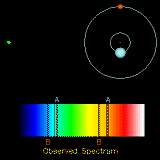Spectroscopic Binary Stars
 This movie simulates a double-lined spectroscopic binary star system
consisting of an F0v primary and M0v secondary in a circular orbit about
each other. The orbital plane is oriented along the line of sight in this
simulation. The top half of the frame shows the appearance of the two
stars seen from above, with the red dot marking the center of mass of the
system, and the green dot at left indicating the location of the distant
observer. The bottom half of the frame shows the spectrum seen by the
distant observer. The absorption lines from the primary star are labeled
"A", while those from the secondary star are labeled "B". As the two stars
orbit each other, they alternately move towards then away from the
observer. This results in their absorption-line spectra getting
blue-shifted, then red-shifted, respectively. The pattern of Doppler
shifts traces out the orbital motions of each star. A thin "stationary"
absorption line appearing between the two lines shows the un-shifted
location of each line.
This movie simulates a double-lined spectroscopic binary star system
consisting of an F0v primary and M0v secondary in a circular orbit about
each other. The orbital plane is oriented along the line of sight in this
simulation. The top half of the frame shows the appearance of the two
stars seen from above, with the red dot marking the center of mass of the
system, and the green dot at left indicating the location of the distant
observer. The bottom half of the frame shows the spectrum seen by the
distant observer. The absorption lines from the primary star are labeled
"A", while those from the secondary star are labeled "B". As the two stars
orbit each other, they alternately move towards then away from the
observer. This results in their absorption-line spectra getting
blue-shifted, then red-shifted, respectively. The pattern of Doppler
shifts traces out the orbital motions of each star. A thin "stationary"
absorption line appearing between the two lines shows the un-shifted
location of each line.
Notice that the primary star's absorption lines (labeled "A") only shift a
small amount, reflecting its smaller orbital velocity, compared to that of
the secondary, which moves much faster. This because the lower mass
secondary star must be located farther from the center-of-mass of the
system than the primary, and so has to trace out a much bigger circle in
its orbit in the same time that the primary does, making its Doppler shift
larger in proportion to their mass ratio.
The amount of Doppler shift seen in this simulation has been greatly
exaggerated to make it easily visible.
[Credit: R. Pogge, OSU]
[Details]
Return to:
[
Lecture 9 Page
|
Unit 1 Page
|
Astronomy 162 Homepage]
Prof. Richard Pogge (pogge@astronomy.ohio-state.edu)
Updated: 1998 January 10 [rwp]
Copyright © 1998
Richard W. Pogge, All Rights Reserved.
